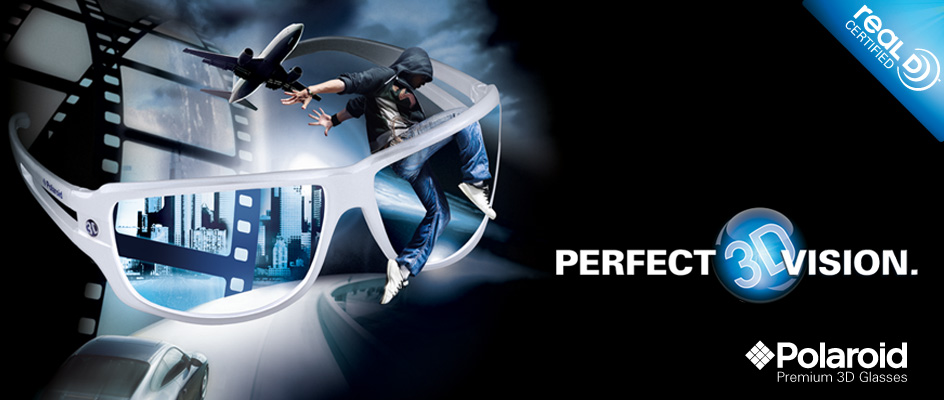- Book Reviews THE HEIR APPARENT by Rebecca Armitage
- Book Reviews THIS IS NOT ABOUT US by Allegra Goodman
- Book Reviews STORM WARNING by James Byrne
- Children's Book Reviews THERE’S NO PLACE LIKE GNOME by Scott Magoon (picture book)
- Children's Book Reviews OUR AIR by G. Brian Karas (Picture Book)
- Book Reviews DETOUR by Jeff Rake and Rob Hart
- Book Reviews THE DEFINITIONS by Matt Greene
- Book Reviews AND THEN THERE WAS YOU by Sophie Cousens
- Book Reviews THE MERGE by Grace Walker
- Book Reviews LIKE FAMILY by Erin O. White
3D Eyewear – The future’s so bright, I gotta wear shades
Industry analysts predict that there will be 64 million 3D television sets in use by the year 2018. That means over 200 million pairs of eyes will be wearing 3D glasses within 7 years! So it’s time for TechDadCentral to learn about the two competing 3D technologies – active and passive — and then offer up some advice.
3D Technology: Active vs. Passive
In Active systems, instead of showing the right and left filmed images at the very same time, visuals from two different perspectives are shown one after the other at a very fast pace.
Active 3D glasses use batteries and must be electronically linked to the screen. The glasses are equipped with shutters in front of each eye. When an image from the left side is shown, the shutter in front of the right eye is closed, so only your left eye can see and vice versa. As this effect happens multiple times per second, the brain doesn’t realize it sees the images one after the other, rather than at the same time. This generates a 3D image from a combination of the images seen from the left and right side and your brain then reconstructs a 3D image.
In Passive systems, the 3D screen shows two images at the same time, one filmed with a camera on the left of the scene and the second with a camera on the right.
During viewing, each eye sees only the image intended for it. The left lens is equipped with a special circular polarized filter that filters out the right image, allowing only the left image to reach the left eye and vice versa. This makes it easy for your brain to reconstruct a perfect 3D image. The glasses used in passive systems do not require a battery or any connection from the glasses to the screen, making them less expensive with a longer product life; and you can take them to your local movie theater to watch 3D films.The vast majority of cinemas, televisions and gaming devices currently use passive 3D technology.
Glasses – you gotta wear shades – and you will probably be buying extras
Most 3D televisions come bundled with a few pairs of glasses. To keep the system price low, these included glasses tend to be cheaply built and less than optimal. As a new 3D owner, one of the first add-ons that you’ll shop for are additional glasses to either replace or augment the included pairs.
 If you have a passive system, take a look at the Perfect 3D Vision line. When it came time for TechDadCentral to learn about 3D glasses, I went to the experts – Polaroid – that have been designing polarized sunglasses forever and are truly the experts in polarization technology. At CES 2011, the Polaroid technical team compared and contrasted the different quality points to look for when buying 3D glasses, namely:
If you have a passive system, take a look at the Perfect 3D Vision line. When it came time for TechDadCentral to learn about 3D glasses, I went to the experts – Polaroid – that have been designing polarized sunglasses forever and are truly the experts in polarization technology. At CES 2011, the Polaroid technical team compared and contrasted the different quality points to look for when buying 3D glasses, namely:
 - Curved lenses that wrap around eliminate disturbing back-reflection from room light = better 3D image viewing
- Curved lenses that wrap around eliminate disturbing back-reflection from room light = better 3D image viewing
– The quality of the polarization can have a dramatic image impact. Poor quality polarization will causes ghosting (multiple images), blurriness when watching fast-action scenes and diminished colors.
– Poor manufacturing of the lens (look for slight color variations of the lens surface) will distort the image.
TechDadCentral is no slave to fashion, but the Polaroid 3D Vision line had a style that fit me and even elicited a thumbs-up from my two teens. Time to sing along with the classic tune from Timbuk 3:
I’m doing all right, getting good grades
The future’s so bright, I gotta wear shades,
I gotta wear shades
-
 THE HEIR APPARENT by Rebecca Armitage
THE HEIR APPARENT by Rebecca Armitage
-
 THIS IS NOT ABOUT US by Allegra Goodman
THIS IS NOT ABOUT US by Allegra Goodman
-
 STORM WARNING by James Byrne
STORM WARNING by James Byrne
-
 THERE’S NO PLACE LIKE GNOME by Scott Magoon (picture book)
THERE’S NO PLACE LIKE GNOME by Scott Magoon (picture book)
-
 OUR AIR by G. Brian Karas (Picture Book)
OUR AIR by G. Brian Karas (Picture Book)
-
 DETOUR by Jeff Rake and Rob Hart
DETOUR by Jeff Rake and Rob Hart







